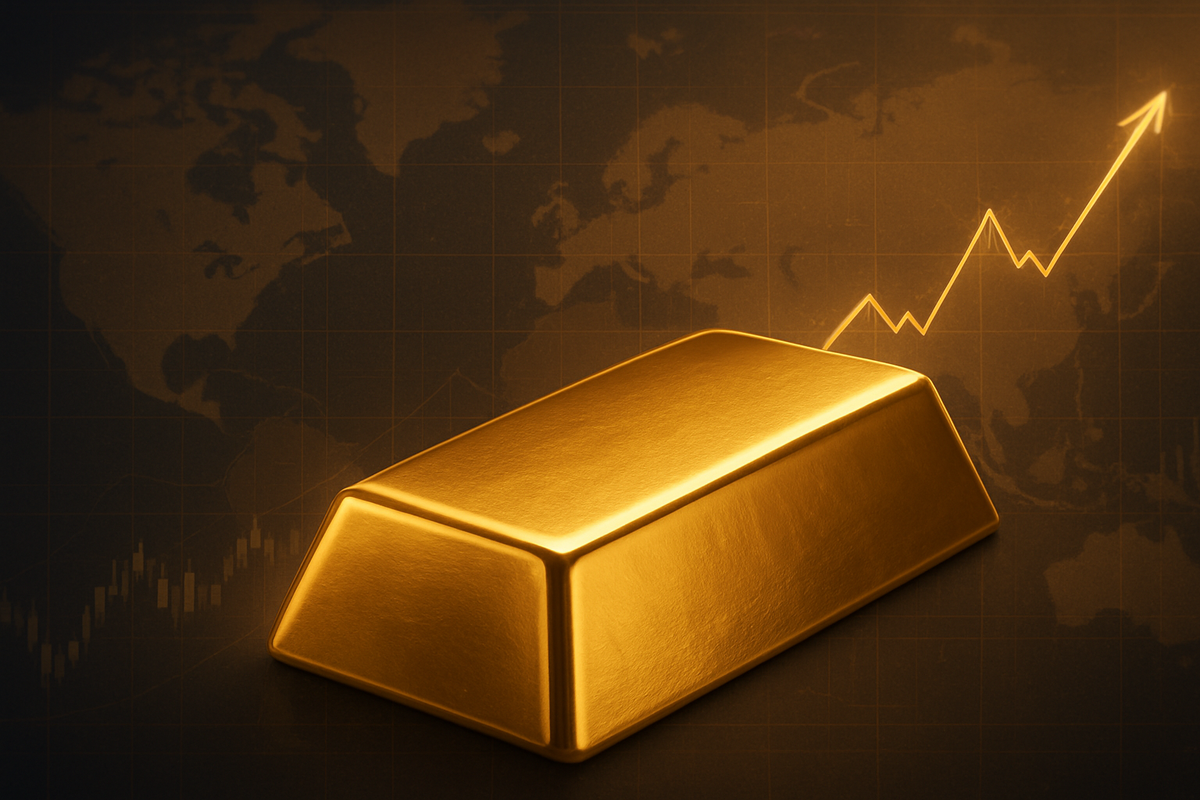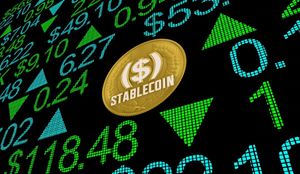Gold's Resilient Pullback: A Healthy Correction or a Warning Sign?

Gold prices have recently experienced a shallow pullback from their record highs achieved in October 2025, a move widely interpreted by market analysts as a healthy consolidation phase rather than a reversal of its robust bullish trend. This dip, though relatively modest in historical terms, has nevertheless sparked a nuanced debate among investors regarding the precious metal's immediate trajectory and its long-term potential. While some view the current weakness as a prime buying opportunity, others are closely scrutinizing economic indicators and geopolitical developments for signs of a deeper correction. The overarching sentiment, however, remains cautiously optimistic, with many market participants anticipating a resumption of gold's upward momentum.
A Closer Look at Gold's Recent Price Action
The yellow metal embarked on an extraordinary bull run in 2025, culminating in unprecedented levels in October, where prices soared to a peak ranging between approximately $4,300 and $4,381.58 per ounce. Following this historic ascent, gold began to retreat, pulling back around $250 per ounce to settle near $4,050 by late October. A particularly sharp plunge occurred on November 15, 2025, when spot gold prices plummeted over 3%, or more than $130, nearing $4,030 per ounce amidst significant intraday volatility. As of November 24, 2025, gold is trading in the range of $4,060 to $4,090 per ounce, representing a decline of roughly 5.8% to 6% from its peak.
This shallow pullback is primarily attributed to a confluence of factors. Technically, the market was severely overbought, with the weekly Relative Strength Index (RSI) reaching an exceptional reading of 92, signaling an imminent need for a correction. Naturally, the rapid climb also triggered short-term profit-taking by investors eager to lock in gains. Briefly, a perceived easing of U.S.-China trade tensions offered a temporary respite from geopolitical anxieties, diminishing safe-haven demand, though this proved short-lived. More significantly, the evolving stance of the Federal Reserve (FED) has played a pivotal role. Initial hawkish signals created temporary headwinds, but recent indications from a Fed official on November 22, 2025, hinting at a possible interest rate cut in the near term, have since provided renewed support for bullion by weakening the dollar and lowering bond yields.
The immediate market implications of this correction are multifaceted. It is largely seen as a healthy consolidation rather than a trend reversal, with many analysts highlighting these periods of weakness as attractive buying opportunities. The market has experienced increased volatility, particularly around mid-November, characterized by sharp intraday swings. Investor focus has intensified on the Federal Reserve's monetary policy, with swap traders now pricing in a 68% chance of a December rate reduction. Historically, lower interest rates tend to benefit gold, as it is a non-yielding asset. Interestingly, gold mining stocks have borne the brunt of the correction more severely than the physical metal, experiencing declines of 15% to over 20%, compared to gold's roughly 6% dip from its peak.
Market sentiment remains largely optimistic about gold's long-term trajectory. While some caution is evident, many investors view the current dip as a "buy on the dips" scenario, given the metal's powerful bullish trend. The resilience of gold bulls is notable, especially with prices holding firmly above the psychological $4,000 level. Comparing this to previous bull markets, where corrections often ranged from 33% to 66%, the current retracement of about 10% appears modest, suggesting a strong underlying trend. The faster-than-expected rebound from this shallow correction further reinforces this perspective.
Corporate Fortunes Tied to Gold's Dance
The recent shallow pullback and the anticipated rebound in gold prices create a dynamic landscape for public companies operating within the precious metals sector. These entities, ranging from direct miners to investment vehicles and royalty streamers, exhibit varying degrees of sensitivity and leverage to the yellow metal's price movements.
Gold mining companies are arguably the most directly and significantly impacted due to their inherent operational leverage. Their profitability is acutely sensitive to the price of gold, as extraction costs tend to be relatively fixed. During a shallow pullback, such as the one recently observed, mining stocks typically experience a more pronounced decline than the underlying commodity itself. For instance, while gold saw an approximately 6% dip from its peak, mining equities corrected by 15% to over 20%. This "downside leverage" can compress profit margins, reduce free cash flow, and potentially impact dividend payouts or debt reduction efforts. Conversely, a rebound in gold prices would likely trigger a substantial rally in these stocks, often outperforming gold's percentage gain, as expanding profit margins attract investors seeking amplified returns. Companies like Newmont Corporation (NYSE: NEM), the world's largest gold producer, with its robust balance sheet bolstered by over $2.5 billion in strategic divestitures in 2025, is well-positioned to weather such pullbacks and benefit significantly from a rebound. Barrick Gold Corporation (NYSE: GOLD), while also a major player, has sometimes seen its stock performance lag due to production setbacks and rising costs; a rebound would necessitate improved operational execution for its stock to fully participate. Similarly, Agnico Eagle Mines Limited (NYSE: AEM), with its diversified operations and reported 1% increase in mineral reserves in 2025, would see enhanced profitability and support for further reserve expansion upon a price recovery.
Precious metal Exchange-Traded Funds (ETFs) offer investors varied exposures to gold's movements. Physical gold-backed ETFs, such as SPDR Gold Shares (NYSEARCA: GLD) and iShares Gold Trust (NYSEARCA: IAU), directly correlate with the spot price of gold. A shallow pullback results in a proportional decrease in their share price, while a rebound leads to a similar proportional increase. These ETFs serve as popular tools for diversification, inflation hedging, and as a store of value. In contrast, gold miner ETFs, like the VanEck Vectors Gold Miners ETF (NYSEARCA: GDX), hold a basket of publicly traded gold mining companies. Consequently, GDX's performance typically reflects the amplified movements of its underlying mining stocks. During a gold pullback, GDX would likely experience a more significant decline due to the inherent leverage of its constituents. Conversely, a gold price rebound would likely lead to a substantial surge in GDX's value as the profitability of the mining companies within its portfolio improves.
Gold royalty and streaming companies, exemplified by Franco-Nevada Corporation (NYSE: FNV) and Wheaton Precious Metals (NYSE: WPM), present a somewhat more insulated business model. These firms provide upfront capital to miners in exchange for a percentage of future production (royalty) or the right to purchase future production at a fixed, lower price (stream). This model grants them low operational costs and high-profit margins, making them less susceptible to the direct cost inflation faced by traditional miners. During a shallow pullback, their stock might decline, but often with less volatility than pure mining companies. Upon a gold price rebound, these companies benefit immensely, as their revenue is directly tied to the commodity price without a corresponding increase in their cost base. This results in significant margin expansion and accelerated free cash flow. Franco-Nevada Corporation (NYSE: FNV), for instance, saw its revenue increase by 42% and net income more than triple in Q2 2025 due to a 40.2% surge in gold prices, demonstrating its powerful leverage to rising prices and its potential for continued dividend growth.
Gold's Enduring Role in a Shifting Global Landscape
Gold's recent shallow pullback and swift rebound in late 2025 are not isolated market anomalies but rather significant indicators of its entrenched and evolving role within a complex web of global financial and geopolitical forces. This resilience, particularly in holding above the critical $4,000 per ounce level after touching historic highs, underscores the metal's sustained wider significance amidst persistent global uncertainties.
The current price action is deeply intertwined with several overarching industry trends. Escalating geopolitical tensions, from the ongoing conflict in Ukraine to renewed instabilities in the Middle East and broader global economic uncertainties, continue to fuel gold's safe-haven appeal. Investors, compelled to seek stable stores of value, have consistently channeled capital into the precious metal. Furthermore, a monumental trend of increased central bank demand and de-dollarization efforts is providing a crucial structural floor for gold prices. Central banks globally, notably those in China, Poland, Turkey, Kazakhstan, and Brazil, are aggressively accumulating gold reserves, driven by a strategic intent to diversify away from the US dollar and bolster financial security against geopolitical risks and currency instability. The anticipated trajectory of US Federal Reserve interest rates also profoundly influences gold; expectations of future rate cuts or a looser monetary policy generally make non-yield-bearing assets like gold more attractive by reducing the opportunity cost of holding them. Lastly, persistent inflationary pressures, even if sticky, reinforce gold's perception as a strong hedge against the erosion of fiat currency purchasing power.
The robust performance and anticipated rebound of gold have several ripple effects across various stakeholders. For gold mining companies, higher gold prices generally translate to increased revenues and profitability, consequently boosting their stock valuations and benefiting investors in gold mining equities and related exchange-traded funds. Gold-backed ETFs have seen substantial inflows, signaling heightened investor confidence and interest in gaining exposure to gold as a diversifier against broader market volatility. Central banks, through their continued aggressive accumulation, reinforce gold's role as a strategic reserve asset, influencing global financial stability and fostering further reserve diversification strategies away from traditional reserve currencies. Moreover, gold's counter-cyclical nature, often acting as a safe haven during economic downturns or stock market volatility, provides essential diversification benefits to investment portfolios.
Regulatory and policy implications also play a crucial role in shaping gold's trajectory. Decisions by the US Federal Reserve regarding interest rates and overall monetary easing or tightening are paramount, as expectations of rate cuts directly reduce the opportunity cost of holding gold. Broader trade policies and tariffs, by contributing to persistent inflation, can indirectly boost gold's appeal as an inflation hedge. Most profoundly, the deliberate policy decisions of central banks to increase gold holdings reflect a strategic shift in sovereign reserve management, often driven by a desire for greater financial autonomy and reduced reliance on the US dollar, with long-term implications for global financial architecture.
Historically, gold's current performance and resilience echo well-established patterns. Analysis of past gold market cycles, particularly from the 1970s and 2000s, suggests that even shallow corrections can be followed by periods of consolidation before the market embarks on its next significant upward phase. Gold's remarkable 50-54% surge in 2025 draws comparisons to its strongest rally since 1979, a period marked by profound global economic and political turmoil, underscoring its consistent performance during times of heightened instability. Events like the 2008 Financial Crisis and the COVID-19 pandemic also demonstrated gold's reliable safe-haven characteristics. Many analysts now suggest that the current market dynamics indicate the early stages of a secular bull market for gold, akin to the early 1970s, implying sustained long-term growth despite short-term fluctuations.
What Lies Ahead: Navigating Gold's Future Trajectory
Following its recent shallow pullback and subsequent swift rebound, the future outlook for gold prices appears predominantly bullish, both in the short and long term. This optimistic forecast is underpinned by a complex interplay of economic, geopolitical, and market-specific factors, which will necessitate strategic adaptations from market participants and close monitoring of emerging opportunities and challenges.
In the short-term (late 2025 - early 2026), the recent pullback from October's record highs (around $4,381.58 per troy ounce) is largely viewed as a healthy technical adjustment within a robust upward cycle. Gold prices have been consolidating around the $4,000 to $4,055 level as of late November 2025. While some forecasts suggest fluctuations, with prices potentially ranging between $3,813 and $4,048 by year-end, others are more sanguine, projecting a rise to $4,456-$4,509 by the end of November, driven by geopolitical turbulence and inflationary expectations. The short-term bias is currently neutral, but aligning market cycles indicate gold may be entering an "escape velocity" phase, projecting upward pressure through mid-December 2025. A retest of the $4,200-$4,250 resistance level remains highly probable, with potential upside targets expanding towards $4,350-$4,500 if this threshold is decisively cleared.
The long-term outlook (2026 - 2030 and beyond) for gold prices is overwhelmingly bullish, with numerous institutions revising their forecasts upwards. This sustained growth is expected to be driven by persistent geopolitical instability and economic uncertainty, reinforcing gold's traditional safe-haven role. Ongoing inflationary pressures, coupled with anticipated shifts in Federal Reserve monetary policy towards easing in 2026, will likely make non-yielding assets like gold more attractive. Crucially, central banks are expected to continue their significant net purchases of gold, diversifying away from US dollar reserve holdings amidst global macro imbalances. Surging US fiscal deficits and national debt are also seen as long-term tailwinds for gold, potentially leading to currency devaluation. Furthermore, structural supply-side constraints, including limited new mine development and rising extraction costs, are expected to support higher prices. Price predictions for 2026 range from $4,000 (J.P. Morgan Research) to $4,600 (Trading News) and even $4,400 (Morgan Stanley). Looking further out to 2027-2030, many analytical platforms project gold to strengthen significantly, trading between $6,000 and $8,500, with some ambitious forecasts suggesting prices could reach $9,382 by 2030 and even $12,262 by 2037.
In this evolving gold market, strategic pivots and adaptations will be crucial for market participants. Investors should continue to view gold as a critical diversification tool and a hedge against inflation and systemic risks, focusing on long-term positioning and viewing pullbacks as accumulation opportunities. Beyond physical gold, exploring opportunities in gold mining companies, ETFs, and other gold-related financial instruments could offer leveraged exposure. Traders will need to hone their technical analysis skills, market timing, and risk management strategies, potentially utilizing gold futures for hedging. For mining companies, diversification of operations, increased investment in R&D, and a strong focus on sustainability and governance (leveraging AI, remote sensing, blockchain, and meeting ESG requirements) will be paramount for accessing capital and maintaining global buyer confidence.
Emerging market opportunities and challenges will also shape gold's trajectory. Opportunities include growing demand from countries like China and India, which have strong cultural ties to gold and increasing wealth, as well as strategic reserve accumulation by emerging nations seeking economic stability. Gold-producing emerging economies could also experience significant economic benefits. However, challenges persist, such as political instability in some emerging markets, the prevalence of illegal mining, market price volatility, potential supply chain disruptions, and the complex interplay of currency dynamics.
The prevailing sentiment points to a "multi-year rerating cycle" for gold. The most likely scenario is a continued upward trajectory, potentially entering a "momentum expansion phase," with prices steadily climbing towards and surpassing the $5,000 mark in the long term, fueled by sustained inflation, central bank buying, a weakening global growth outlook, and ongoing de-dollarization. While short-term consolidation periods and further pullbacks are expected (possibly drifting towards $3,700), these would likely be viewed as healthy corrections within a larger bull market, building a new base for future advances. Bearish risks, though less likely for the long term, include an overly hawkish Federal Reserve, a significant reduction in geopolitical tensions, or a robust global economic recovery that diminishes gold's safe-haven appeal.
Conclusion: Gold's Enduring Allure Amidst Global Flux
Gold's recent shallow pullback from its October 2025 record highs has proven to be a healthy, technical consolidation rather than a fundamental reversal, reinforcing the metal's robust underlying strength. This period of price adjustment, marked by profit-taking and temporary shifts in market sentiment, has done little to dampen the overwhelmingly bullish long-term outlook. The confluence of persistent inflation, anticipated Federal Reserve interest rate cuts, aggressive central bank demand driven by de-dollarization efforts, and ongoing geopolitical tensions are creating a powerful and durable tailwind for gold prices.
The market moving forward is characterized by a strong consensus among major financial institutions for continued upward momentum, with numerous upward revisions to price targets for 2026 and beyond. Gold is increasingly being seen as a central component of risk diversification strategies, potentially entering a prolonged secular bull market akin to the early 1970s. Its ability to outperform other major asset classes further underscores a potential rotation of capital into the precious metals complex.
For investors, the key takeaway is gold's enduring role as a store of value and a hedge against systemic risks in turbulent times. The recent pullback offered a valuable opportunity for accumulation. In the coming months, investors should closely monitor the Federal Reserve's monetary policy decisions, the performance of the US dollar, global inflation data, and the evolving geopolitical landscape. The pace of central bank gold purchases and ETF investment flows will also be critical indicators of structural demand. Technically, watching gold's ability to hold key support levels around $3,970 and break through resistance zones, particularly $4,100-$4,145 and $4,200-$4,250, will provide crucial insights into its immediate trajectory. While short-term volatility is to be expected, the structural drivers supporting higher gold prices suggest that the metal's shine is far from fading, positioning it as a pivotal asset in diversified portfolios for years to come.
This content is intended for informational purposes only and is not financial advice
More News
View More




Recent Quotes
View More
Quotes delayed at least 20 minutes.
By accessing this page, you agree to the Privacy Policy and Terms Of Service.